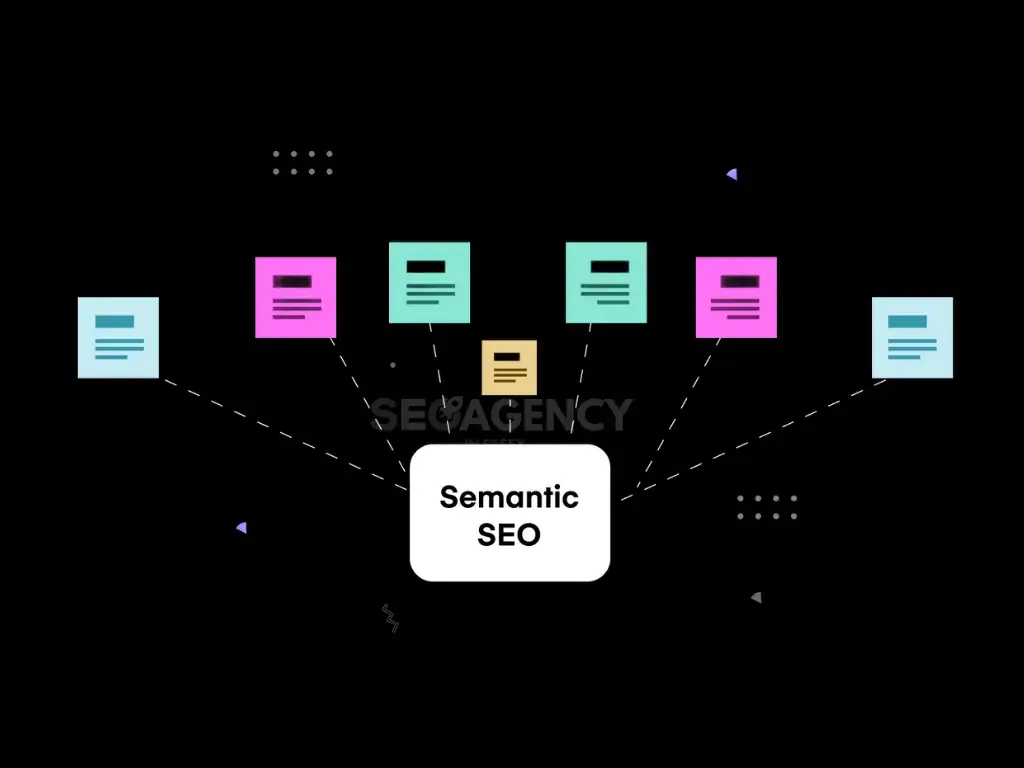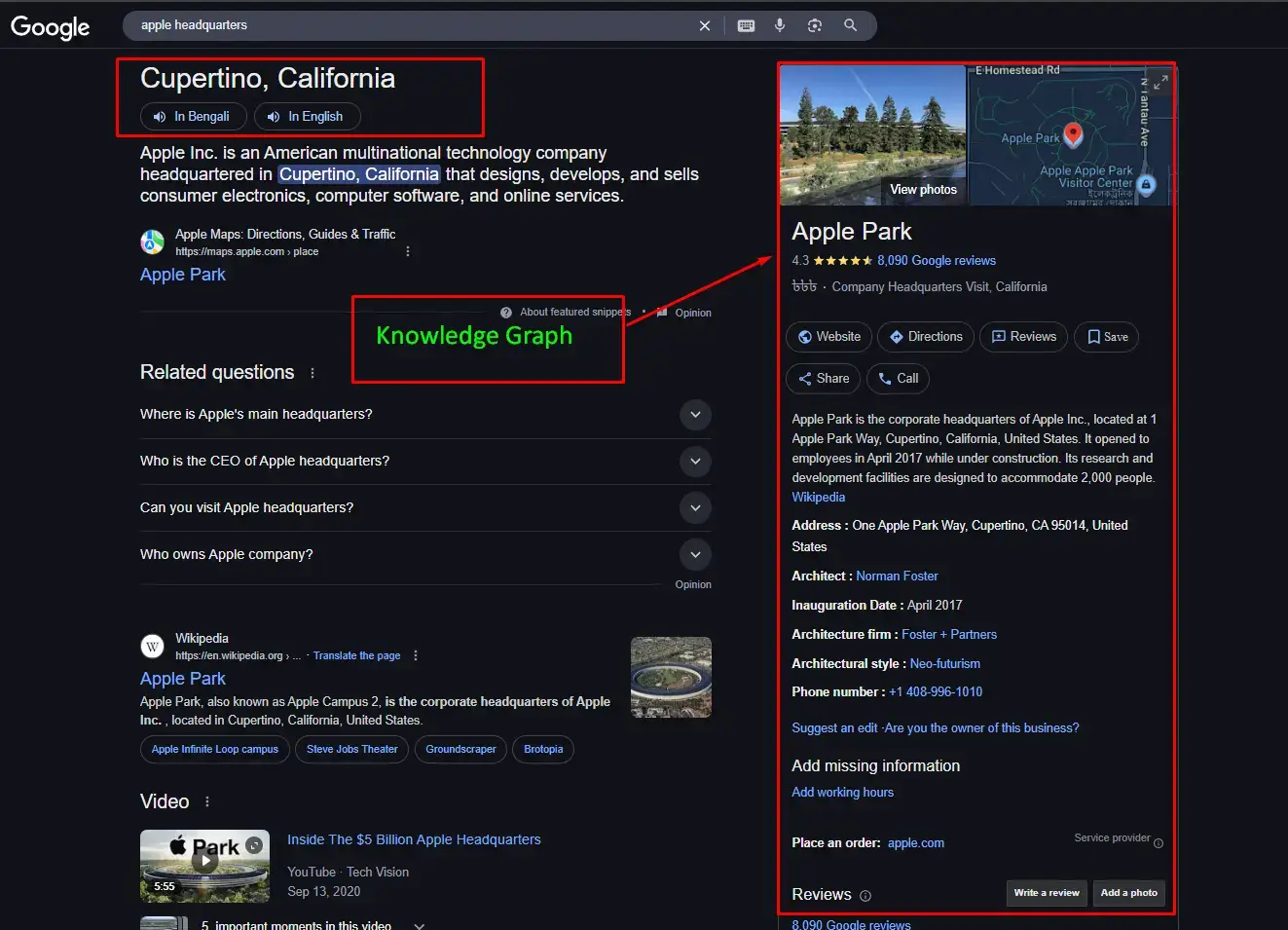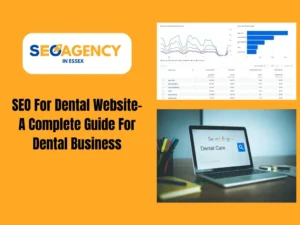Understanding AI Semantic SEO
Semantic SEO is an advanced approach to optimising web content that emphasises meaning and context rather than focusing solely on specific keywords.
This method involves understanding the intent behind a search query and creating relevant content that fully addresses the user’s needs.
By adopting AI Semantic SEO, businesses can stay competitive in an ever-evolving digital landscape, where search engines increasingly prioritise content that aligns with user intent and provides real value.
The Shift from Keywords to Context
Traditional SEO strategies relied on identifying high-traffic keywords and embedding them throughout content to achieve higher rankings for specific terms.
In contrast, Semantic SEO goes beyond keyword matching, focusing on a comprehensive understanding of a topic.
This approach involves crafting content that covers subjects in-depth, provides valuable insights, and addresses user questions, resulting in content that is more relevant and useful to readers.
Beyond Words: Understanding Queries
With Semantic SEO, AI-driven algorithms consider synonyms, variations, and related terms to grasp the full context of a search query.
This strategy encourages content structuring that holistically addresses user queries, covering various angles and relevant information.
By understanding the deeper intent behind search queries, businesses can deliver content that meets user expectations and improves visibility in search results, leading to a more impactful online presence.
The Role of AI and Machine Learning in Semantic SEO

AI-Powered Understanding of Context
Artificial intelligence (AI) and machine learning are driving forces behind the evolution of Semantic SEO, enabling search engines to grasp the intent and context of queries beyond simple keyword matching.
These technologies allow search engines to understand the deeper relationships between concepts, themes, and the context surrounding a search.
With AI-powered algorithms, vast amounts of data are Analysed to reveal patterns and connections that shape more effective Semantic SEO strategies, allowing businesses to deliver content that truly resonates with user intent.
Enhancing Search Accuracy with AI
AI significantly enhances search accuracy by improving how well search engines interpret user intent. When a query is entered, AI algorithms consider factors like phrasing, user history, and similar searches to accurately predict what information the user is seeking.
This predictive capability allows businesses to craft content that not only answers specific queries but also aligns with users’ broader needs and interests.
By leveraging AI, businesses can deliver more relevant, valuable content, which enhances user engagement and boosts online visibility.
The Evolution of Search and the Rise of Semantic SEO
In the early days of the Internet, search engines operated on a rudimentary system of keyword matching.
Webmasters, eager to climb the search engine ranking ladder, exploited this system through manipulative tactics like keyword stuffing – the practice of overloading web pages with specific keywords to try and trick search engines.
However, as technology progressed, search engines evolved too. The introduction of advanced algorithms and natural language processing (NLP) marked a paradigm shift in the world of search.
Search engines were no longer simply matching keywords; they began to understand the meaning and context behind search queries, ushering in the era of semantic search.
Semantic SEO, in essence, is the practice of aligning your content with this evolution of search. It’s about moving beyond simply targeting keywords to focusing on the intent behind those keywords. It’s about understanding what your audience is really looking for and crafting content that provides comprehensive and relevant answers to their questions.
Why Semantic SEO Matters: Benefits for Content Creators and Businesses
In today’s digital landscape, semantic SEO is no longer just a “nice-to-have”—it’s a necessity. Here’s why:
- Dominate the Search Rankings: Semantic SEO helps content rank higher in search engine results because it aligns with how search engines are now interpreting search queries. By understanding and catering to user intent, you are speaking the same language as search engines, increasing your chances of ranking higher for relevant searches.
- Unlock a Flood of Organic Traffic: Semantic SEO enables websites to attract more qualified visitors from organic search. When you create content that comprehensively addresses a topic and its related concepts, you increase the likelihood of ranking for a broader spectrum of semantically related keywords, expanding your reach and attracting a larger audience.
- Craft an Unforgettable User Experience: Content that genuinely caters to user intent provides a more satisfying and engaging experience for visitors. By answering their questions in a clear, concise, and informative manner, you keep users on your site longer, reduce bounce rates, and establish yourself as a trustworthy source of information.
- Future-Proof Your SEO Wins: The digital landscape is constantly evolving. Search engines are constantly refining their algorithms and introducing new ways to understand and interpret user behavior. Semantic SEO, by its very nature, is about adapting to these changes. By focusing on core principles like user intent and topical relevance, you build a strong foundation that can withstand algorithm updates and ensure your content remains optimised for the future.
Key Google Algorithm Updates that Shaped Semantic SEO

The evolution of semantic SEO is closely intertwined with key Google algorithm updates that revolutionised how search engines understand and interpret online content.
Let’s explore some of the most impactful updates that shaped the semantic search landscape:
- Hummingbird (2013): This hummingbird update marked a turning point in Google’s ability to understand natural language. Hummingbird moved beyond analysing individual keywords to processing entire phrases and recognising the relationships between words. This enabled Google to better grasp the meaning behind complex queries and deliver more relevant search results.
- RankBrain (2015): Building upon Hummingbird, RankBrain introduced machine learning to the search algorithm. This AI-powered system enhanced Google’s ability to interpret ambiguous or conversational queries. By learning from user behavior and analysing vast amounts of data, RankBrain helped Google understand the nuances of human language and deliver even more accurate search results.
- BERT (2019): BERT, an advanced NLP model, further refined Google’s understanding of context and word relationships. By analysing the words surrounding a search query, BERT helped Google grasp the subtle nuances of language and deliver more relevant results, especially for longer, more complex queries.
These updates, along with many others, demonstrate Google’s commitment to understanding the true intent behind user queries and delivering the most relevant and helpful search results.
As a content creator, it’s crucial to stay informed about these updates and adapt your SEO strategies accordingly.
The Power of the Knowledge Graph in Semantic Search

At the heart of Google’s semantic search capabilities lies the Knowledge Graph, a massive database that stores information about entities and their interconnected relationships.
Imagine a vast network of nodes and edges, where each node represents an entity (a person, place, thing, concept, or idea) and each edge represents the relationship between those entities.
This intricate web of knowledge allows Google to go beyond simple keyword matching and understand the context of search queries.
For example, if you search for “best restaurants in Paris,” the Knowledge Graph helps Google understand that “Paris” refers to the city in France and that you are looking for establishments categorised as restaurants.
This deeper understanding of context has significant implications for SEO. Entity-based SEO focuses on optimising content for entities and their relationships within the Knowledge Graph.
By aligning your content with how Google structures and understands knowledge, you can increase the chances of appearing in relevant search results and knowledge panels.
Core Principles of AI Semantic SEO: Crafting Content with Meaning
To excel in the world of semantic search, content creators must adopt a holistic, AI-driven approach to SEO. Here are the key principles to elevate your Semantic SEO strategy:
1. Understanding User Intent: The Foundation of Semantic SEO with AI
While keywords remain important, user intent is now central to SEO. Optimising for semantic search involves understanding the underlying goals and questions driving search behaviour.
- Beyond Keywords: Keywords are just a starting point. The key is understanding the “why” behind searches. What problems are users trying to solve? What information are they seeking? This deep dive into intent enables more meaningful content.
- Types of Search Intent: User queries can be classified into four main intents:
- Informational: Seeking knowledge or answers (e.g., “what is semantic SEO”).
- Navigational: Searching for a specific site or page (e.g., “LinkedIn login”).
- Transactional: Ready to make a purchase (e.g., “buy cat food online”).
- Commercial Investigation: Researching products before buying (e.g., “best laptops 2025”).
- Leveraging AI-Powered Tools: Use tools like People Also Ask (PAA) boxes and AnswerThePublic to discover common user questions and gain insights into search intent. For example, if your target keyword is “project management software,” these tools can reveal questions like:
- What are the benefits of project management software?
- How to choose the right software for my team?
- Best free options available?
By addressing these questions, you provide a richer, intent-focused resource that resonates with users.
2. Creating Topically Relevant Content: Building Authority and Depth
AI Semantic SEO thrives on in-depth, topically relevant content that builds authority across a subject.
- Focus on Middle Keywords: Instead of focusing on long-tail keywords with limited search volume, shift to broader, mid-range keywords that cover a range of related subtopics. This approach supports more in-depth content and attracts a wider audience.
- Organise with Content Outlines: A well-structured outline is your secret weapon. Break complex topics into sections and subtopics to ensure complete coverage and logical flow.
- Embrace Long-Form Content: Longer, comprehensive content pieces demonstrate authority and attract more backlinks. For instance, if writing about “content marketing strategies,” a robust outline might include:
- Content Marketing Basics: Define and explain key concepts.
- Content Types: Cover blogs, videos, infographics, etc.
- Strategy Development: Guide readers through creating a plan.
- Content Creation & Distribution: Offer tips on production and distribution.
- Measurement & Optimisation: Explain how to track success.
In-depth, topically rich content provides value and helps rank for various related terms, building authority across the subject.
3. Leveraging Semantic Keywords with AI: Painting a Fuller Picture
Semantic keywords are contextually related terms that expand and enhance the depth of your content.
- Identify Related Concepts: Use AI-driven tools like Ahrefs and SEMrush to discover commonly associated terms. For example, if your topic is “digital marketing,” semantic keywords might include “SEO,” “content marketing,” “social media,” “email marketing,” and “analytics.”
- Natural Integration: Avoid forced insertion of semantic keywords. Instead, create high-quality, readable content where these terms naturally fit. For instance, in a blog post on “healthy eating,” you might organically include terms like:
- Nutrition: Discuss the importance of balanced nutrients.
- Meal Planning: Provide meal preparation tips.
- Exercise: Highlight the link between diet and fitness.
By weaving semantic keywords throughout, you enhance content relevance for both search engines and readers.
4. Optimising for Conversational Search: Speaking the Language of Users
With the rise of voice search, optimising for conversational queries is increasingly vital.
- Use Natural Language: Write clearly and conversationally. Avoid technical jargon, focusing on how people might naturally phrase questions about your topic.
- Think Like a Voice Searcher: Anticipate the types of questions users might ask through voice search. Queries tend to be longer and more specific, reflecting the need for direct answers. For example, rather than “best dog food,” voice searchers might ask, “What’s the best dog food for puppies?”
- Provide Clear Answers: Structure your content to include concise, clear answers for common questions. Anticipate and address specific needs, ensuring your content is relevant and engaging.
By following these core principles, you can create content that aligns with AI-driven semantic SEO, satisfying both user intent and search engine algorithms.
This approach ensures your content remains relevant, valuable, and highly ranked in an evolving digital landscape.
Advanced Semantic SEO Tactics: Going Beyond the Basics
To truly master semantic SEO, you need to go beyond the fundamental principles and implement more advanced tactics that will give you a competitive edge in search results.
Building Topical Authority with AI

AI can play a powerful role in establishing topical authority, helping businesses build domain expertise by strategically guiding content creation and optimisation.
Identifying Content Opportunities
AI’s analytical capabilities allow businesses to uncover valuable content opportunities that might otherwise go unnoticed.
By analysing trends, user behaviour, and competitor content, AI can identify gaps in existing resources and highlight areas where new content is needed.
This enables businesses to create content that is both highly relevant and tailored to the interests of their target audience, strengthening their authority on specific topics.
Optimising Content for Depth and Relevance
AI-driven insights can also help optimise content for both depth and relevance, key factors in building topical authority.
By ensuring content thoroughly covers a topic from multiple angles, businesses can provide a more comprehensive resource that resonates with readers and aligns with search engine algorithms.
The strategic use of AI in content optimisation enhances SEO performance and contributes to a more engaging, informative user experience, ultimately positioning the business as a trusted thought leader within its industry.
By leveraging AI for content strategy and optimisation, businesses can build topical authority that not only drives SEO success but also fosters lasting credibility with their audience.
2. Implementing Structured Data: Adding Context for Search Engines
Structured data, also known as schema markup, is a way to provide search engines with explicit information about the content on your pages. It uses a standardised vocabulary to mark up specific elements of your content, making it easier for search engines to understand and categorise your pages.
- Understanding Schema Types: Different types of schema markup are available, tailored to specific types of content. For example, you can use schema markup for articles, products, events, recipes, local businesses, and more.
- Unlocking Rich Snippets: While schema markup may not directly impact rankings, it can lead to rich snippets in search results. These enhanced search results display additional information, such as star ratings, reviews, pricing, and event details, which can improve click-through rates.
- Utilizing Tools and Resources: Tools like Google’s Structured Data Testing Tool can help you validate your schema markup and ensure it is implemented correctly.
By incorporating structured data into your web pages, you provide search engines with a clearer understanding of your content, enhancing its visibility and potential for appearing in relevant search results.
3. Optimising Image Alt Text: Enhancing Accessibility and SEO
Alt text, short for alternative text, is a brief description that is added to images on web pages. While its primary purpose is to improve accessibility for visually impaired users who use screen readers, alt text also plays a role in SEO.
- Describing Image Content: Write clear and concise alt text that accurately describes the content of each image. Avoid using generic terms like “image” or “picture.” Instead, provide specific details that help search engines understand the visual content.
- Using Keywords Strategically: If relevant, incorporate your target keywords into the alt text, but don’t force them in unnaturally. The focus should always be on providing an accurate and informative description.
- Considering Image Search: optimise your alt text with image search in mind. When people search for images using keywords, Google uses alt text to understand the content of images and deliver relevant results.
By crafting well-written alt text, you not only improve your website’s accessibility but also enhance its visibility in image search results.
4. Optimising for People Also Ask (PAA) Questions: Addressing User Queries

The People Also Ask (PAA) section in Google search results provides valuable insights into the related questions and concepts that users are searching for in relation to a particular topic.
By optimising your content to address these PAA questions, you demonstrate a deep understanding of user intent and enhance the comprehensiveness of your content.
- Analysing PAA Boxes: When researching a topic, pay close attention to the PAA boxes that appear in the search results. These questions represent the most common queries that users have related to your target keyword.
- Incorporating PAA Answers: Naturally, incorporate answers to PAA questions within your content. You can create dedicated sections that address these questions or weave the answers seamlessly into the existing flow of your content.
- Adding Value: The goal is not just to answer the questions but to provide valuable and insightful information that enhances the user’s understanding of the topic.
By effectively addressing PAA questions, you create content that is not only informative but also highly relevant to what users are searching for, increasing the likelihood of ranking higher in search results.
The Future of AI Semantic SEO: Trends and Predictions
The world of search is rapidly advancing, propelled by AI innovations and the increasing interconnectedness of digital platforms. Here’s a look at key trends and predictions shaping the future of semantic SEO:
1. The Rise of AI-Powered Search
AI, especially generative AI models like ChatGPT, is transforming the way search engines operate.
These tools are now capable of generating summaries of search results, directly answering user queries, and creating more personalised, conversational experiences.
As AI becomes integral to search, content creators will need to optimise for AI-readability, ensuring their content is well-structured and provides immediate, relevant answers.
2. Personalisation and Contextual Relevance
AI is enabling a new level of personalisation in search results by considering factors like user preferences, location, search history, and even time of day.
For content creators, this means crafting content that not only resonates with target audiences but is also contextually relevant to each search.
This shift emphasises the importance of understanding audience segments and creating adaptable content that meets specific user needs.
3. The Blending of Search with Other Platforms
Search engines, social media platforms, and voice assistants are increasingly overlapping in functionality.
Users are discovering and consuming content across multiple platforms, requiring a more integrated SEO approach.
As search engines rely more on signals from social and multimedia platforms, content creators must adapt their strategies to include SEO for interconnected digital spaces, such as social media, podcasts, and voice search.
As AI semantic SEO continues to evolve, those who embrace these trends and adapt to the changing landscape will be positioned for long-term success in search visibility and user engagement.
Measuring and Enhancing SEO Performance with AI
AI technology offers a sophisticated approach to understanding and improving SEO performance, enabling businesses to make smarter, data-driven decisions.
Advanced Analytics for SEO Insights
AI-powered analytics tools provide a deeper level of SEO insight beyond traditional metrics. These tools analyse complex patterns in user behaviour, search trends, and competitive landscapes to reveal hidden opportunities for growth.
By using AI to track SEO performance, businesses can gain actionable insights that allow them to adjust strategies in real-time and stay ahead of shifts in the digital landscape.
Optimising SEO Strategies with AI
With AI-driven insights, businesses can refine and enhance their SEO strategies with greater precision.
AI can recommend specific actions—such as adjusting keywords, improving content relevance, or targeting emerging trends—that are tailored to boost SEO performance.
By continuously optimising based on AI recommendations, businesses can enhance their online visibility, increase traffic, and ultimately improve their competitive edge in search engine rankings.
By integrating AI into SEO measurement and strategy, businesses can adopt a more agile, informed approach to SEO, driving sustained improvements in performance and visibility.
How an AI Semantic SEO Agency Can Boost Your Business Growth
Partnering with an AI semantic SEO agency can transform your digital presence and drive business growth. Here’s what an agency can do to help you reach new levels of online success:
- Advanced Keyword & Intent Analysis: Utilise AI-driven tools to uncover high-value keywords and understand user intent, aligning your content precisely with audience needs.
- Content Strategy & Optimisation: Develop comprehensive content strategies that go beyond keywords, focusing on topical relevance, depth, and engagement to establish authority.
- Technical SEO Enhancements: Optimise your website’s technical elements, including site speed, structure, and mobile responsiveness, ensuring a seamless user experience that supports SEO goals.
- AI-Driven Analytics & Reporting: Track performance using advanced AI-powered analytics, enabling continuous improvements through data-driven insights.
- Voice & Conversational Search Optimisation: Optimise content for natural language and conversational queries to capture more traffic from voice search and mobile users.
An AI semantic SEO agency leverages cutting-edge tools and strategies to elevate your visibility, helping your business stay competitive and grow organically.
Conclusion
AI Semantic SEO is not a final destination; it’s an ongoing journey that requires constant adaptation and refinement. As search engines evolve and user behaviours shift, content creators need to stay agile and embrace AI Semantic SEO principles to stay competitive.
To succeed in the world of semantic search, keep these core takeaways in mind:
- Understand Your Audience: Move beyond keywords to fully understand the intent, questions, and needs of your target audience.
- Create Comprehensive Content: Deliver in-depth, valuable information that covers topics thoroughly, addressing all relevant aspects.
- Leverage Semantic Keywords: Enrich your content with conceptually related words and phrases that help search engines capture the full context of your message.
- Stay Ahead of the Curve: Keep up-to-date with the latest algorithm updates, trends, and best practices in AI Semantic SEO to ensure your content remains optimised in an ever-evolving digital landscape.
By focusing on these principles, you’ll be well-equipped to create content that thrives within the semantic web, offering value to users and building your competitive edge.




